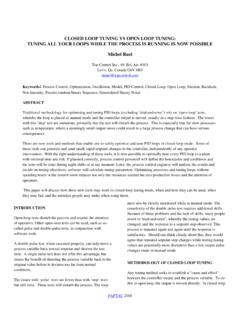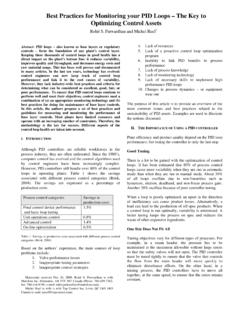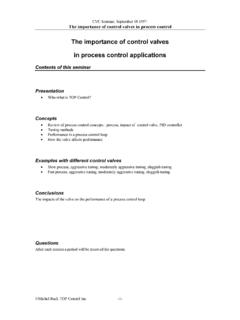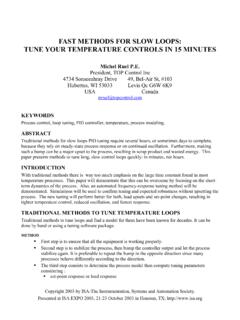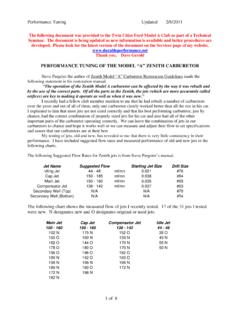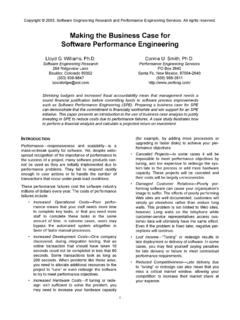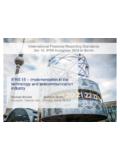Transcription of A simple method to determine control valve …
1 A simple method to determine control valve performance and its impacts on control loop performance Michel Ruel , Top control Inc. Keywords Process optimization, tuning, stiction, hysteresis, backlash, dead time, positionner, performance . Summary A control loop consists of the process, measurement, controller, and a final control element ( valve , damper, etc. and its associated equipment such as positionner, I/P). Optimal process control depends on all of these components working properly. Hence, before tuning a loop, one must verify that each component is operating properly and that the design is appropriate.
2 Choosing the optimal PID tuning should be done after making sure all of the other components are working properly. Our experience in the field has shown us that the impact of good tuning is more important than equipment performance itself. We will discuss a method to determine if the valve is performing well and this is done while the process is running. We will demonstrate how a poorly performing valve will have a minimal effect on control loop performance if the tuning parameters are not optimal. However, if a control loop is tuned to achieve performance , the control valve behavior will have a major impact on performance .
3 Introduction In North America, the majority of control loops have not been tuned to reach optimal performance . Very often, during installation, the tuning parameters are left as the manufacturer defaults. When problems occur with control loops, people often tend to reduce the tuning parameters, as this is the quickest way to reduce instability. For example, if a valve has some backlash, the loop will have a tendency to oscillate. If the technician reduces the tuning parameters, he will then hide the problem (which will get bigger and bigger as time goes by) and will also make the loop slower to respond.
4 Tuning should be considered a major part of a control loop. Why spend a lot of money on expensive equipment if we only use it to fraction of its potential? It is hard to identify when a valve is damaged or needs to be replaced, if the tuning has not been done correctly. In this article, disturbance responses of perfect and real world valves will be analyzed using aggressive and sluggish tuning. The results will show that tuning has a major impact on the performance of control loops. Many criteria can be used to evaluate control loops: stability, overshoot, removing quickly a disturbance, etc.
5 valves , non linear devices When a command has been given to a control valve for a new position, the behavior of the valve will vary depending on its position, its direction and the amplitude of the signal. Examples: 1. When the position change is small, the dead time of the valve is generally longer than it would be for a bigger change. In fact, the positioner must supply enough to overcome stiction. When changes are more important, the behavior of the valve is similar to a linear system. 2. When the signal is very big, saturation will prevent the valve from moving faster than a set pace.
6 3. Certain valves will not behave the same when they are opened and when they are closed. 4. Since the torque that moves the valve varies in accordance with the opening and the process conditions, the valve s dynamic behavior is not the same on the entire range. 5. Backlash causes hysteresis. 6. Seals and seats cause stiction. 7. The positioner causes overshoot. 8. The inherent characteristic curve of the valve is often ignored during selection. Instead of reducing the gain variations according to the load, it increases them. The effects of control valves Dead time When a simple position change is made, the dead time is generally long.
7 Indeed, the positioner provides a small airflow and pressure slowly builds up. If a positioner is not tuned to be sensitive, the dead time will be even longer. Time constant (tau) The valve time constant is due to the actuator reservoir which fills with air as a first order system (time constant). If a positioner has been tuned too loosely, the time constant will be longer. Many manufacturers offer positioners with different capacities, depending on the size of the actuator. When bigger changes are made, the speed is limited and the time constant appears longer.
8 Hysteresis, Backlash, Dead Band The position of a valve with hysteresis will vary whether the signal increases or decreases. Hysteresis usually comes from backlash, but is can also be caused by non-linearities such as seals or friction. Hysteresis provokes oscillations and reduces performance . When a change occurs, hysteresis will also add to the dead time. Backlash :If mechanical parts are loose, when reversing direction, the valve movement will be different from the signal. Resolution:The resolution is the smallest increment of input signal in one direction for which movement of the valve is observed.
9 Resolution is caused by a sensor like a wirewound resistor; each loop of wire produces an output jumping each time a new loop is reached. Also, digitizing a signal will do the same. For example, the resolution for an 8 bits system is 1/256= Figure 1 illustrates the terms: dead band, resolution, backlash and hysteresis. Figure 1 rbrdhSignal appliedValve positionr :resolutionb :backlashd: :perfect valve If resolution is perfect, backlash=deadband=hysteresis. Figure 2 illustrates how a valve with backlash responds. Figure 3 shows how the valve responds to bumps.
10 Figure 2 h=b=dSignal appliedValve positionr :resolutionb :backlashd: :perfect valve Figure 3 illustrates also how to determine the backlash in a valve . If the backlash is zero, the valve position and hence the process variable will go back to the previous position. Ideally, backlash in a valve is zero, but in most valves , it is near 1 %. On most processes, a backlash of 2 or 3 % is acceptable if the controller is not tuned too aggressively. Such backlash adds dead time to the loop and reduces performance . Usually, the backlash and hysteresis are almost equal. Figure 3 timeValve positionbacklashValve positionApplied signal Stiction Anything that comes in contact with the moving parts of a valve will create friction; the seats, the seal, etc.
